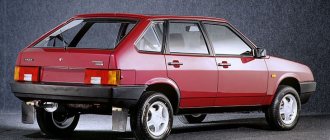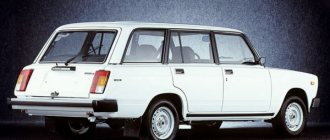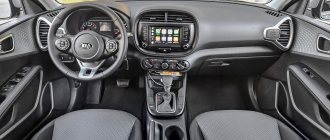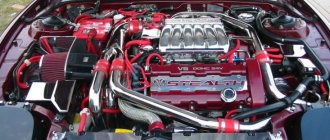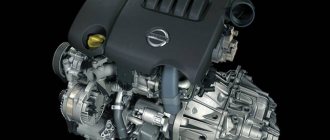Content
- From the history
- Initial characteristics
- Options
- Advantages and disadvantages
- Price
- Opinions about the car
- Problems when buying a KIA Rio
Korean companies are increasingly winning the car market from their competitors. One of the popular budget cars is KIA Rio. In 2017 alone, almost 100 thousand cars were sold in Russia. The model is well equipped and has a modern appearance at a very affordable price.
What is the secret of such popularity? Are there really no flaws in the car? Let's find out!
Pros and cons of the first generation Kia Rio (2000 – 2005)
Kia Rio 1st generation (DC)
Pros:
- Reliability of the design.
- Interior materials are inexpensive, but wear-resistant.
- Easy to maintain.
- The stove and air conditioner do their job well.
- Reliable suspension .
- Small travel of the manual transmission lever and precise gear shifting.
- Resource engine .
- The spacious luggage compartment of the Kia Rio 2003 Hatchback has a cigarette lighter , thanks to which you can place a car refrigerator or connect other necessary accessories.
- Economical fuel consumption.
- Good equipment even in basic versions.
Trunk Kia Rio (DC) station wagon
Disadvantages:
- The main disadvantage is rotting sills and wheel arches .
- Mediocre sound insulation.
- Due to the wear of the plastic part on the trapezoid, the right wiper begins less well . The element is not expensive and is easy to change.
- The main problem is the wheel bearings . They are conical, two on each wheel. When replacing them, it is necessary to install only original spacer rings and observe the tightening torque.
- The fuel level sensor sometimes provides incorrect information.
- It is recommended to reduce the timing belt replacement interval.
- When the air conditioner is turned on, engine thrust drops . In the city this will not cause a problem, but on the highway you can feel it when overtaking.
After restyling the Kia Rio in 2002, sound insulation improved, the brakes became better, and some other shortcomings were corrected.
Equipment of Kia Rio 1
The basic package of the Kia Rio includes:
- front electric windows;
- electrically adjustable mirrors;
- central locking;
Central locking, electric windows and electrically adjustable outside mirrors. - air conditioner;
- audio system;
- driver's airbag.
Driver airbag, radio, air conditioning.
In addition, for the 1st generation Kia Rio the following were offered as options :
- leatherette interior;
- signaling;
- additional airbags;
- power sunroof;
- ABS and EBD;
- heated front seats.
From the history
“Rio” begins its history back in 2000. It was then that the first generation was released. The car did not make a big splash, becoming an ordinary utilitarian option in the budget price category.
In 2005, the second generation came out. German designers have already worked on the model, and the appearance turned out to be more aggressive and interesting. Petrol versions were available: 1.4, 1.6 liters and even diesel 1.5 liters. The result is an unpretentious budget car that meets the requirements of buyers.
The Rio, built on the basis of the Hyundai Solaris, has gained real popularity. This was already the third generation, launched in 2011.
In 2021, the fourth generation of the popular sedan launched. But we will dwell in more detail on the third version - the most famous on the secondary market.
Initial characteristics
The model has a bright “youth” appearance. The car is equipped with two gasoline engines:
- 1.4 l 107 hp 5-speed manual transmission, 4-automatic transmission are available;
- 1.6 l 123 hp With 6-speed manual transmission or 6-automatic transmission.
The first consumes 7-8 liters per hundred in urban mode, depending on the type of gearbox. A more powerful version - about 10 liters of gasoline.
The body style is available in both sedan and station wagon versions. But sedans are more popular. MacPherson strut front suspension is the most common and simplest design. At the back there is a regular “beam”. Therefore, you should not expect excellent handling and comfort when driving over bumps from the model.
Characteristics of Kia Rio / Kia Rio
The Kia Rio debuted at the Geneva Motor Show in 2000. The car replaced the discontinued Avella. It belongs to class B, has a transverse engine, front-wheel drive and is built on the same platform as Sephia/Shuma. The model was produced in three body styles: a 4-door sedan, a 5-door hatchback and an original station wagon with a rounded rear end.
Modern design, a comfortable interior, a spacious trunk, good build quality and a reasonable price allowed the car to earn many favorable reviews.
The salon welcomes passengers with a cozy interior, but the quality of materials is low, which is logical considering the cost of the car. The driver's seat is comfortable, with good lateral support, and is adjustable in length, backrest angle and cushion height. Ergonomics are at a good level, all controls are at hand. The scales on the dashboard are well arranged - the speedometer occupies the central place, and there is also a tachometer.
The standard equipment of most Rios includes power steering, air conditioning, central locking with remote control, an airbag, power windows in the front doors, electric mirrors, the ability to open the gas tank flap and trunk from the passenger compartment, and a stereo system. Additional equipment includes: ABS with electronic brake force distribution, front airbags, electric sunroof, CD changer.
The range of power units consists of two gasoline engines: 1.3 liter with 84 hp. and 1.5 liters with 108 hp. There are two transmissions to choose from: a 4-speed automatic transmission and a 5-speed manual transmission. The front brakes are ventilated disc brakes, and there are drums at the rear.
In 2003, Kia Rio was restyled. The model receives an updated design: the headlights have become larger and more expressive. The body structure has been changed. The hood, roof and rear parcel shelf have undergone improved sound insulation. Sound-absorbing material is used in the trunk, floor, and the distance between the dashboard and the engine compartment.
After five years of successful production of the Kia Rio, the Koreans decided to release the second generation of this car. Kia Rio II features a completely new, more modern and, in a sense, “European” body design, as well as a different interior design. The car received the correct, almost classic proportions.
Rio II is built on a completely new platform, which will be used not only by Kia, but also by Hyundai. The wheelbase has increased from 2410 to 2499 mm. Thanks to the increased base and track, the car has become much more stable on the road and handles better. Now, in terms of dimensions, Rio is as close as possible to the C-class models: length – 4238 mm (+23 mm), width – 1694 mm (+14 mm), height – 1470 mm (+30 mm). The total volume of the cabin is 2,611 m³. The trunk volume has been increased by 29% and reaches 337 liters (+76 liters), and it can also be increased by folding the rear seat backs.
External changes affected primarily lighting technology. New headlights in a modern, fashionable style have noticeably refreshed the front of the Rio. The others were the front bumper, hood and radiator grille. In general, the appearance of the car seems to have changed slightly, but it has become more sleek and modern.
The interior has been updated much more significantly. Thus, the design of the front panel has been completely redesigned. Previously, it clearly defined the driver's workplace - the center console and the area around the instrument panel were made as a single whole and stood out against the general light background with the texture and black color of the plastic. Now only part of the center console is highlighted in a similar way. As a result, the front panel looks more seamless and organic. The instrument cluster is somewhat different in design from the previous one, although it is similar in composition, simplicity and information content.
It has become much more spacious inside. This primarily affected the rear passengers. The driver's seat, as before, is equipped with many settings, including separate adjustments for the height of the cushion. The interior has expanded, which allowed the manufacturer, instead of a narrow shelf on the door of a first-generation car, to make a full-fledged armrest and place control buttons for mirrors and electric lifts on it.
The new Rio continues to be equipped with independent front and semi-independent rear suspension. At the front are time-tested McPherson struts, and at the rear are torsion bars. Plus there are front and rear stabilizers.
Rio II is offered in two versions - Base and LX. The basic version (Base) is quite ascetic and includes only 6 airbags, three-point belts, four mechanical adjustments for the driver's seat and a heated rear window. In the LX package, this list is much richer: power steering and steering column height adjustment, air conditioning, an audio system with a CD changer and four speakers, a 60/40 folding rear seat backrest, and a full-size spare wheel.
There is also a so-called Power Package, which is only available for the LX trim level. It includes power windows and mirrors, keyless entry, heated mirrors, two high-frequency speakers in the front doors, additional interior lighting and a pocket for sunglasses. For lovers of a sporty image, a sports package is offered, which includes a more expensive interior trim, 15-inch alloy wheels with 195/55 R15 tires, disc brakes on all wheels, fog lights, a rear spoiler, metallized body enamel, aluminum pedals, leather steering wheel trim and gearshift lever.
Two gasoline engines intended for the new Kia Rio have added 100 cubic meters each, becoming 1.4- and 1.6-liter (110 hp), respectively. The engines are equipped with a variable valve timing system CVVT.
The power unit is combined with either a five-speed manual transmission or a four-speed automatic, which is available upon request.
In addition to size and power, the new Rio has carefully worked on safety. The car already has six airbags as standard: two front, two side and two full-size “curtains”. The front airbags are adaptive - the degree of their filling with gas depends on the position of the seat, the speed of the collision and the signal from the seat belt sensor. Basic safety features include front seat belt pretensioners and force limiters, a 3-point belt for a third rear passenger and two child seat anchors. But ABS, rear disc mechanisms and power steering are available only for an additional fee.
With the new design, the Kia Rio has become more attractive to younger buyers. This spacious, quite comfortable and practical car looks modern and European.
The official presentation of the third generation Kia Rio took place on March 1, 2011 - the opening day of the Geneva Motor Show. It is noteworthy that a slightly different version of Rio is sold in the Korean, European and American markets. The Kia Rio for Russia was based on the version for the Chinese market - Kia K2 - and adapted for Russian conditions. The Rio sedan for the Russian market has been produced since August 2011 in St. Petersburg; production of hatchbacks started a little later at the beginning of 2012.
The car is based on the front-wheel drive platform that underpins the Solaris and which also underpins the Hyundai i20 hatchback. The front has McPherson struts with a transverse stabilizer, and the rear has trailing arms. For better controllability, the steering mechanism is equipped with an electric booster, and to increase the level of safety, disc brakes with ABS and ESP are installed on all wheels.
The appearance of the third Kia Rio is strikingly different from previous generations, and this is due in no small part to Peter Schreyer, former director of Volkswagen Design. A sporty, dynamic mood is set by the wedge-shaped front end of the car, the continuation of the idea is noticeable in the athletic stampings of the sidewalls, and the final touch is outlined in the taut rear. Another important difference between the updated Kia Rio is its increased size; the wheelbase has increased by as much as 70 mm, which has a positive effect on interior space. Ground clearance - 160 mm.
The inside has become more spacious and comfortable. The driving position is quite comfortable, thanks to the adjustable seat and steering column. Unfortunately, the steering wheel can only be adjusted for height (within a range of 40 mm), but not for reach. The dashboard is quite informative and features a horizontal architecture. Everything you need to control the auxiliary systems is at your fingertips. Finishing materials have become more expensive; two-color panels are optionally available.
The trunk has become wider, and its useful volume has increased to 500 liters, while the folding back of the rear sofa in a 60/40 ratio allows you to transport oversized cargo.
The third generation Rio on the Russian market is equipped with two petrol “fours” of the Gamma series - with a volume of 1.4 liters (107 hp, 135 N•m) and 1.6 liters (123 hp and 155 N•m). The most powerful engine can accelerate the car to hundreds in 10.3 seconds, and the 1.4-liter has a moderate “appetite” of about 6.0 liters per hundred. The cylinder block of both engines is aluminum, as is the upper part of the crankcase. The gas distribution mechanism with a phase shifter at the inlet is driven by a chain. The power supply system with distributed injection is adapted to run on AI-92 gasoline and is designed for cold starts at -35°C. The engines are equipped with a five-speed manual gearbox or a four-speed automatic transmission. Of course, more is available to Europeans. U2 turbodiesel engines and environmentally friendly ISG technology are available for them.
The car is presented in four trim levels (Comfort, Luxe, Prestige and Premium), while the list of available options is extensive, there is a Russified on-board computer, heated mirrors and windshield, leather trim on the steering wheel, gearshift lever and dashboard, as well as other pleasant and useful little things. The basic Comfort package offers: two airbags, ABS, air conditioning, front electric windows. The Luxe package will delight you with a CD/MP3 audio system, rear electric windows, heated front seats and fog lights. In the Prestige version: side airbags and curtain airbags, climate control, leather-trimmed steering wheel and gear lever, alloy wheels. In the maximum Premium configuration: six airbags, a stabilization system, an audio system with Bluetooth protocol support, keyless entry into the cabin, a leather-trimmed dashboard visor, 16-inch alloy wheels and parking sensors.
The five-year warranty declared for Rio (or 150 thousand km) applies to the engine and gearbox. And the warranty period for shock absorbers, CV joints, silent blocks and steering elements is 70 thousand km.
Options
"Rio" is made in four main versions: Comfort, Luxe, Premium, Prestige.
There is nothing interesting about the car itself. No air conditioning, no full power accessories. Only the front windows work with the button. But there are still two airbags: the driver and the front passenger. The engine is only 1.4 liter. Everything has been done to ensure maximum availability of cars for buyers.
In older trim levels, a simple utilitarian car has the following options:
- Driver, front passenger airbags, window curtains and side airbags;
- Leather steering wheel with multimedia controls and heating;
- Heated front seats, windshield and windshield washer nozzles;
- Climate control;
- Multimedia from USB;
- The ESC system is added to ABS;
- Keyless entry;
- Rear parking sensors.
That's all the amenities. There is not even such a common option as leather interior. But the quality of the fabric is different from the standard one. Easy-to-clean fabric is used on both the seats and the interior door trim.
Advantages and disadvantages
To get a budget car, manufacturers reduce the quality of parts and materials. This inevitably leads to certain customer dissatisfaction, especially if the model was technically unsuccessful. Let's sort it out in order.
Pros:
- Low fuel consumption. For 1.4 l only 8 liters in the city, for 1.6 l - 10 liters;
- Strong, durable and cheap to repair suspension. Stabilizer strut — 390 rub. Ball joints - 330 rubles each. per piece, and the lower front arm - 2500 rubles;
- Reliable simple automatic transmission. Apart from changing the oil, it does not require frequent repairs;
- Reliability of components and assemblies. The car, as a rule, does not need to be replaced or repaired;
- Large trunk (500 l);
- Spacious salon. The front driver and passenger do not interfere with each other's elbows, and the rear can accommodate three passengers of average build.
Car owners treat this car condescendingly. Simple, reliable - for such a budget price they are willing to forgive some of the flaws that inevitably must occur in such a price segment.
Minuses:
- Stiff suspension. Uneven roads are poorly compensated for, causing “shaking”;
- The 1.4 liter engine is rather weak, especially for the highway due to the short fifth gear of the manual transmission. It is sometimes dangerous to overtake;
- Poor sound insulation. At high speed on the highway it is impossible to talk calmly with your interlocutor;
- The “leather” on the steering wheel and gearbox is of poor quality - it will peel off quickly;
- Low ground clearance 16 cm;
- Poor quality of plastic interior. It is hard and scratches easily;
- The stove fan is noisy at high speeds.
With such a list, you can easily “live” and enjoy the car you bought. There is nothing critical - the main dissatisfaction consists of quite expected things. By eliminating them, the manufacturer would inevitably increase the starting price of the model.
According to the famous Euro NCAP test, the KIA Rio received a maximum of 5 out of 5 stars, which is rare in this price segment.
Station wagon interior
Kia Rio (DC) interior
The 2001 Kia Rio sedans and station wagons have an almost identical interior . The interior is decorated with inexpensive gray plastic and simple fabric . But the cheap finish is more than compensated for by the interior equipment.
A distinctive feature of the 1st generation Kia Rio station wagon is the ergonomic driver’s seat.
Front seats and 2nd row of seats Kia Rio 1st generation
The comfort of the entire cabin is excellent. The front seats have lateral support , the driver's seat has adjustable tilt and height . The second row in the form of a sofa is quite comfortable, but for tall Europeans there is not enough legroom.
Front panel and instrument panel of Kia Rio 1st generation
The dashboard is very informative, the steering wheel is power-assisted , and the trunk capacity the sedan 326 liters, and that of the station wagon is 449 liters . A noticeable drawback of the 2001 Kia Rio is poor sound insulation.
Trunk Kia Rio (DC) station wagon
During the 2002 restyling, the manufacturer made special efforts to improve sound insulation in the cabin and the partition in the engine compartment.
Brake system of the basic version without ABS: 1 – brake system high pressure line pipe;
2 – brake pedal; 3 – main brake cylinder; 4 – vacuum brake booster; 5 – front disc brake mechanism; 6 – caliper; 7 – rear drum brake mechanism; 8 – working brake cylinder; 9 – additional tank; 10 – hydraulic control unit; 11 – parking brake cable; 12 – parking brake lever. The braking system and suspension have also been upgraded. According to the characteristics of the Kia Rio 2002 station wagon, it is a compact European class B.
Restyling in 2002 led to updated dashboard and interior materials. The upholstery on the doors and a recess for a can or bottle of drink was added to the pockets. Although the car is a budget car, its equipment has not deteriorated.
Opinions about the car
For greater objectivity, we took the comments “first-hand.” People who currently own Rio and have probably already encountered some difficulties.
Sergey. Moscow. KIA Rio 2012, 1.6 l, automatic transmission:
“The car is good for everyone. The rear row of seats can be conveniently disassembled, increasing the space for carrying cargo. Economical in terms of fuel consumption. I didn't find any cons. Nothing of the major components has changed, only consumables, filters, pads and fluids.”
Evgenia. Ekaterinburg. KIA Rio 2015, 1.4 l, automatic transmission:
“We took it new from the showroom. My husband and I have already traveled 80 thousand kilometers. The car is very comfortable, especially for the money. We're not even going to sell. Of the breakdowns, I don’t remember any serious ones involving large expenses. The most expensive thing was probably buying winter tires. The rest is repaired once every 5-6 months at the service station and that’s it.”
Gennady. Muravlenko. KIA Rio 2011, 1.6 l, manual transmission:
“I bought a taxi car specifically that is unpretentious to frost. Here in the north it can reach -45 degrees. Total mileage 250 thousand km. Of these, mine ran about 180 in 3 years. Once in the winter it didn’t start, it twisted and didn’t catch. I never found out the reason. I do it myself in the garage, so it costs mere pennies. The biggest breakdown is that I change the heater motor every year. In winter, the stove “turns” from morning to night at high speeds. But the car is warm.”
As we see, the owners are happy with their cars; the only complaints concern the operation of the stove for a driver from a city with a very cold climate.

